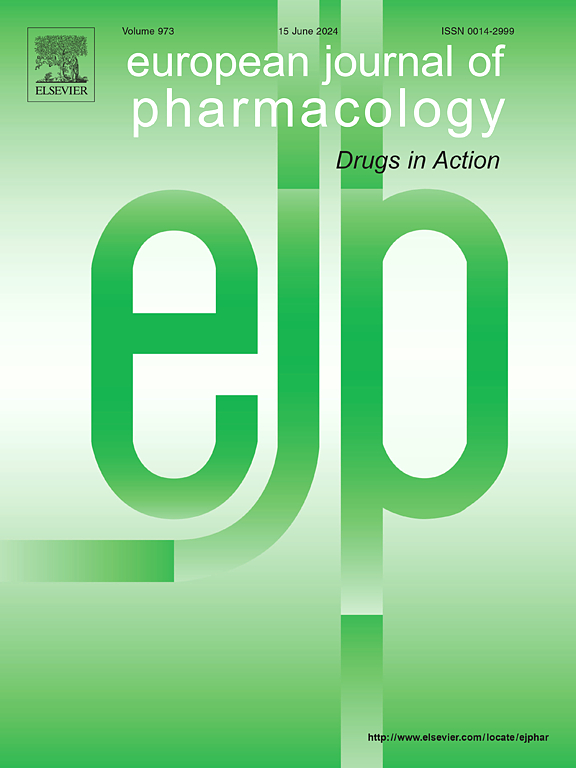Estradiol replacement enhances sweet taste preference in ovariectomized Rats: Interaction with energy intake regulation
IF 4.2
3区 医学
Q1 PHARMACOLOGY & PHARMACY
引用次数: 0
Abstract
Estrogens exert anorectic and anti-obesity effects via homeostatic regulation. However, their role in hedonic ingestive behavior, particularly in sweet taste preference, remains unclear. We examined the effects of estradiol replacement on the intake of sweetened solutions, water, and total energy in ovariectomized rats with concurrent access to sweetened solutions, water, and a standard rodent chow. Compared with the non-replaced (E2 (−)) group, the estradiol-replaced (E2 (+)) group exhibited a higher intake of various sweetened solutions, including those containing non-caloric artificial sweeteners and natural sugars. Food intake was lower in the E2 (+) group than in the E2 (−) group. Total energy intake was lower in the E2 (+) group than in the E2 (−) group when rats consumed water, sucralose, and fructose, but not when rats consumed glucose or sucrose. To explore the involvement of μ-opioid receptors in the estrogen-induced enhancement of sucrose intake, we chronically infused naltrexone (NTX), a partial μ-opioid receptor antagonist. NTX attenuated sucrose intake in the E2 (+) group but not in the E2 (−) group. By contrast, NTX reduced food intake in the E2 (−) group. Additionally, c-Fos expression in the nucleus accumbens shell was attenuated by NTX in the E2 (+) group during the short-term sucrose preference test. These findings suggest that estrogen enhances sweet taste preference and that available palatable glucose or sucrose diminishes the estrogen-induced attenuation of homeostatic energy intake. Moreover, μ-opioid receptors possibly play a role in the estrogen-induced enhancement of hedonic sweet taste preference, while they are involved in the enhancement of homeostatic food/energy intake in the absence of estrogen.
雌二醇替代增强去卵巢大鼠的甜味偏好:与能量摄入调节的相互作用。
雌激素通过体内平衡调节发挥厌食和抗肥胖作用。然而,它们在享乐性摄食行为中的作用,特别是在甜味偏好中,仍不清楚。我们研究了雌二醇替代对去卵巢大鼠加糖溶液、水和总能量摄入的影响,这些大鼠同时获得加糖溶液、水和标准啮齿动物食物。与未替代(E2(-))组相比,雌二醇替代(E2(+))组对各种甜味溶液的摄入量更高,包括那些含有无热量人工甜味剂和天然糖的溶液。E2(+)组的食物摄取量低于E2(-)组。当大鼠摄入水、三氯蔗糖和果糖时,E2(+)组的总能量摄入低于E2(-)组,但当大鼠摄入葡萄糖或蔗糖时则不然。为了探讨μ-阿片受体在雌激素诱导的蔗糖摄入增加中的作用,我们长期输注部分μ-阿片受体拮抗剂纳曲酮(NTX)。NTX减少了E2(+)组的蔗糖摄入量,但在E2(-)组没有。相比之下,NTX减少了E2(-)组的食物摄入量。此外,在短期蔗糖偏好试验中,E2(+)组的伏隔核壳中c-Fos的表达被NTX降低。这些发现表明,雌激素增强了对甜味的偏好,可获得的可口葡萄糖或蔗糖减少了雌激素诱导的体内平衡能量摄入的衰减。此外,μ-阿片受体可能在雌激素诱导的享乐性甜味偏好增强中发挥作用,同时在缺乏雌激素的情况下,μ-阿片受体也参与了稳态食物/能量摄入的增强。
本文章由计算机程序翻译,如有差异,请以英文原文为准。
求助全文
约1分钟内获得全文
求助全文
来源期刊
CiteScore
9.00
自引率
0.00%
发文量
572
审稿时长
34 days
期刊介绍:
The European Journal of Pharmacology publishes research papers covering all aspects of experimental pharmacology with focus on the mechanism of action of structurally identified compounds affecting biological systems.
The scope includes:
Behavioural pharmacology
Neuropharmacology and analgesia
Cardiovascular pharmacology
Pulmonary, gastrointestinal and urogenital pharmacology
Endocrine pharmacology
Immunopharmacology and inflammation
Molecular and cellular pharmacology
Regenerative pharmacology
Biologicals and biotherapeutics
Translational pharmacology
Nutriceutical pharmacology.

 求助内容:
求助内容: 应助结果提醒方式:
应助结果提醒方式:


